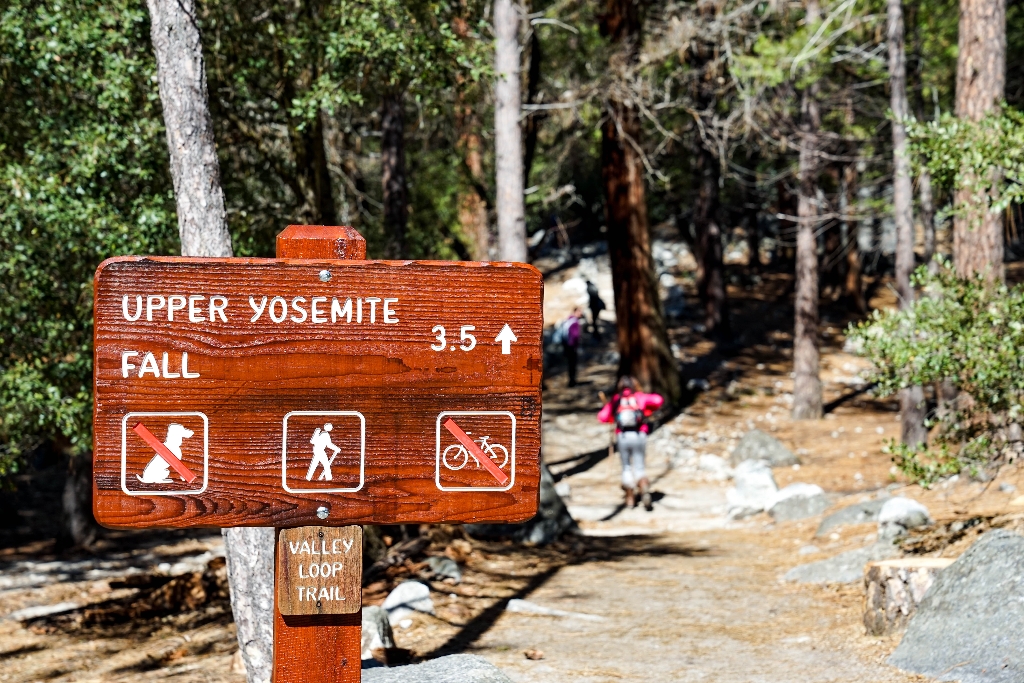
Overview
One of Yosemite's oldest historic trails (built 1873 to 1877), the Yosemite Falls Trail leads to the top of North America’s tallest waterfall, which rises 2,425 feet (739 m) above the Valley floor. This trail starts near Camp 4, along the Valley Loop Trail, and immediately begins its climb, switchback after switchback, through oak woodland. You will begin to climb above some trees and into exposed plateaus that offer you a glimpse of what's to come: great views of Yosemite Valley and its many iconic landforms. Do not stray off of the maintained path, as you will find steep drops adjacent to the trail.
If you make the one-mile, 1,000 foot climb (via dozens of switchbacks) to Columbia Rock, you will be rewarded with spectacular views of Yosemite Valley, Half Dome, and Sentinel Rock. From there, it is worth the time and energy to hike another 0.5 miles (0.8 km) (some of which is actually downhill!) to get a stunning view of Upper Yosemite Fall. Depending on the season, you may even feel the mist from the fall, which may be welcome respite after the tough climb.
The upper half of the trail is steep and rocky, but the arduous climb is well worth the amazing views you will be rewarded with at the top. Here you may be surprised by the small size of Yosemite Creek, which feeds this massive waterfall. Use extreme caution when near the creek and remember you are directly above a waterfall.
Columbia Rock
Distance: 2 miles (3.2 km) round trip
Elevation: 1,000 ft (328 m) elevation gain
Difficulty: Moderate
Time: 2-3 hours round trip
Begin at: Camp 4 area (near shuttle stop #7)
Top of Yosemite Falls
Distance: 7.2 miles (11.6 km) round trip
Elevation: 2,700 ft (823 m) elevation gain
Difficulty: Strenuous
Time: 6-8 hours round trip
Begin at: Camp 4 area (near shuttle stop #7)
Hours
Year-round.
The Yosemite Falls Trail is open year-round; conditions vary depending on the season. In spring, when the waterfall is at its peak, this hike is stunning, and you may even get wet from the spray of the waterfall during a section of the hike. In summer, conditions are hot and dry, and the loose decomposed granite along the trail can be slippery. Keep in mind that by August, the water levels are low and you may only see a trickle here. During winter, the lower portion of this trail gets direct sunlight, so hiking can be snow-free while other trails are icy. Visiting Columbia Rock, located one mile up the trail, is a worthwhile trip at any time of year. The upper portion of this trail, which receives little to no sunlight in winter, can be very icy and slippery, or buried beneath feet of snow, making traction difficult. In winter, hiking in the colder early morning or late afternoon hours can be even more dangerous if the trail is icy.
Getting Here
Begin at the Yosemite Falls Trailhead, beyond the Camp 4 parking lot (Yosemite Valleywide shuttle stop #7)
Rules & Regulations
- Pets and bicycles are only permitted on paved bike paths.
- Pack out what you pack in.
- Overnight backpackers need a wilderness permit, which can be obtained at the Yosemite Valley Wilderness Center.
- Bear canisters are required for wilderness food storage for overnight hikers.
Hazards & Warnings
- Wading and/or swimming upstream from waterfalls is extremely dangerous. Each year, unsuspecting visitors drown or are swept over to their deaths.
- Stay on trails: taking shortcuts causes trail erosion-and is both dangerous and illegal.
- Carry (and drink) plenty of water: Be sure to treat river, stream, lake, or spring water.
- Be prepared for sudden changes in weather and conditions.
- Feeding and approaching wildlife is dangerous and illegal! Be sure to properly store your food.
- Rocks in and around waterways are often slippery. Use caution when crossing streams.
- During winter, the upper portion of this trail, which receives little to no sunlight, can be very icy and slippery, or buried beneath feet of snow, making traction difficult.
Accessibility
This trailhead and associated trail is not accessible.
Is there something we missed for this itinerary?
Itineraries across USA


















































